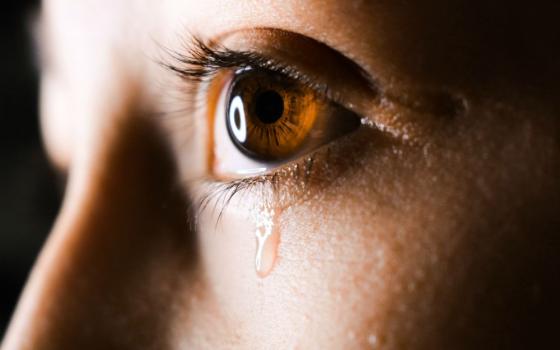There are tears, and then there are tears.
I was eating lunch with Jana Whitmore, manager of the Sylvania Franciscan gift shop, All Good Things. While we were unpacking items I had taken to a sale and reflection day at Westminster Presbyterian Church in Dayton, Ohio, I told her that the staff had taken me on a tour through their massive church.
The church was dark and smelled of wooden pews and candle wax. When we arrived in their sanctuary to see their newly cleaned Tiffany stained glass window, their organist was practicing a bombastic, well-known toccata, and I burst into tears. Am I the only one who sheds tears at different events and in certain environments?
Jana said she cries at events, too.
"Whenever I go to any service at Queen of Peace Chapel, I take tissues with me. I cry every time I attend something there." She said if she forgets her tissues, she borrows some from someone in a neighboring pew.
So why do we cry? The why of crying might seem obvious — we cry when we are happy or sad. We cry at milestone events in our lives: graduations and weddings, other life accomplishments, funerals or excellent performances and concerts.
"Crying is a natural emotional response to certain feelings, usually sadness and hurt. But then, people cry under other circumstances and occasions," says Stephen Sideroff, a staff psychologist at Santa Monica-University of California, Los Angeles.
"For instance, people cry in response to something of beauty. There, I use the word 'melting.' They are letting go of their guard, their defenses, tapping into a deeper place inside themselves."
Another cause of crying is pseudobulbar affect, "a condition that's characterized by episodes of sudden uncontrollable and inappropriate laughing or crying. Pseudobulbar affect typically occurs in people with certain neurological conditions or injuries, which might affect the way the brain controls emotion."
Over the years, scientists have found greatness even in one of the most minute phenomena — human tears. Biochemist William Frey has spent 15 years as head of a research team studying tears. Tears have numerous critical functions. Emotional tears are a response which only humans have, for only people can weep. All animals that live in air produce tears to lubricate their eyes. Only people possess the marvelous system that causes crying.
Not all tears are equal. At the St. Paul Ramsey Medical Center in Minnesota, tears caused by simple irritants were compared to those tears brought on by emotion. Frey found that stress-induced tears removed toxic 'substances' from the body. Volunteers cried from watching sad movies and then from freshly cut onions. Researchers found that tears from the movies, called emotional tears, contained far more toxic biological by-products. They concluded that weeping is an excretory process which removes toxic substances that normally build up during emotional stress.
When we see a beautiful work of art, attend a sacred service or a lovely concert, we may cry tears of beauty. These emotional tears seem to be tapping into our deeper, spiritual selves. We might not have words to express this experience of beauty or wonder, but we somehow know it is a spiritual event in our lives. We actually cry and feel better. We are healed and cleansed a little bit.
Scientific studies show that tears and "crying it out" may be a way to deal with emotional problems. After crying, people usually do feel better, both physically and emotionally — and they feel worse by suppressing their tears, sometimes, because they do not want to be seen crying in public.
Along with emotion, tears have many physical functions in our bodies.
After blinking, a film of tear fluid coats the surface of the eye at a certain thickness and is maintained for a while. This is called tear stability. Tears not only keep the eye moist but also have an important role in maintaining the healthy functioning of the eye.
According to Otsuka Pharmaceuticals, besides preventing dryness, some functions of tears include: protecting the eye from external irritants, supplying it with oxygen and nutrients, (there are no blood vessels on the surface of the eye), and smoothing the eye's surface so that light is refracted correctly, enabling us to see clearly. Moreover, tears contain a substance called lysozyme, which has an antibacterial action and prevents invasion and infection by microbes; tears also contain components that heal damage to the eye surface.
We are in good company with people who cried. Jesus wept at the tomb of Lazarus. He also wept over the city of Jerusalem, and in our time, we weep over police violence in our cities, events in Jerusalem and Baghdad and hurricanes in Puerto Rico and South Carolina, and the refugee cities in Palestine and the Sudan and elsewhere. A Yiddish proverb says, "What soap is for the baby, tears are for the soul."
I do not need scientific proof that I am experiencing a sacred event when I cry during a religious service, view a picture at the museum, or attend a live concert. It is for me, a deep, intimate, holy moment that touches me with tears and not words. I cherish these moments.
So, for crying out loud, shed a few tears. It's good for you!
[Karen Jean Zielinski is a member of the Sisters of St. Francis of Sylvania, Ohio. She sometimes writes for Healthy Living News — a local health magazine — and is regularly published in two national magazines. Her first book, Hope and Help for Living With Illness deals with health and spirituality. She is co-director of associates and director of Canticle Studio, a creative office of products that focus on spirituality and health.]

